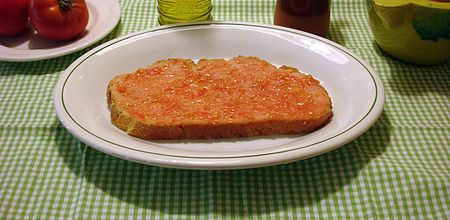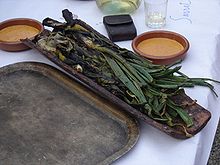- Catalan cuisine
-
Catalan cuisine is a Mediterranean cuisine from Catalonia. It may also refer to the shared cuisine of Roussillon and Andorra, which has a similar cuisine to the Alt Urgell and Cerdanya comarques, often referred to as "Catalan mountain cuisine".[1] It is considered a part of Western Mediterranean cuisine.
Contents
Alternative views
Some contemporary Catalan authors, such as Josep Pla,[2] Jaume Fàbrega or Eliana Thibaut i Comalada,[3] and others like Colman Andrews,[4] have suggested that, besides Catalonia proper, this cuisine takes in the Balearic and Valencian cuisines,[5] but this opinion is challenged as politicised,[4] and is not widespread, nor is supported by either the Catalan,[6] Balearic or Valencian government.[7][8] In any case, mutual ties do exist between Catalan gastronomy and other Western Mediterranean gastronomies, such as Balearic cuisine, Valencian cuisine, Southern French cuisine, Aragonese cuisine or Murcian cuisine.
Basic ingredients
It relies heavily on ingredients found along the Mediterranean coast, including fresh vegetables (especially tomato, garlic, eggplant (aubergine), capsicum, and artichoke), wheat products (bread, pasta), Arbequina olive oils, wines, legumes (beans, chickpeas), mushrooms, all sorts of pork preparations (sausage from Vic, ham), all sorts of cheese, poultry, lamb, and many types of fish like sardine, anchovy, tuna, and cod.
The traditional Catalan cuisine is quite diverse, ranging from pork-intensive dishes cooked in the inland part of the region (Catalonia is one of the main producers of swine products in Spain) to fish-based recipes along the coast.
The cuisine includes many preparations that mix sweet and savoury and stews with sauces based upon botifarra (pork sausage) and the characteristic picada (ground almonds, hazelnuts, pine nuts, etc. sometimes with garlic, herbs, biscuits).
Savoury dishes
- Catalan-style cod (with raisins and pine nuts)
- Escalivada (various grilled vegetables)
- Escudella (a stew, it may served as soup with pasta and minced meats and vegetables, or as the soup first and then the rest)
- Ollada (meat and vegetable stew)
- Esqueixada (salted cod salad with tomato and onion)
- Mongetes amb botifarra (beans and pork sausage)
- Pa amb tomàquet (bread smeared with an olive oil, garlic and tomato sauce)
- Tonyina en escabetx (tuna escabeche)
- Suquet de peix (a seafood casserole)
- Savoury Coca
- Mar i Muntanya ("Sea and Mountain") dishes, which combine meat and seafood
- Embotits, a generic name for different kinds of cured pork meat, including Fuet (a characteristic type of dried sausage) and Salchichón or Llonganissa (salami).
- Calçots (specially cultivated onions, grilled and served as a "Calçotada")
- Cargols a la llauna (cooked snails)
- Sonsos
Sauces and condiments
- Allioli, a thick sauce made of garlic and olive oil, used with grilled meats or vegetables, and some dishes. Allioli means garlic (all) and (i) oil (oli) in Catalan.
- Samfaina, also called tomacat or pebrots amb tomàquet. It's a variety of Occitan ratatouille or Spanish Pisto.
- Salvitxada (made from almonds, hazelnuts, garlic, bread, vinegar, tomatoes, olive oil and dried red peppers) from Valls.
- Xató, a variety of Salvitxada without tomatoes.
Sweets and desserts
- Crema catalana, the famous yellow cream made with yolks, milk and sugar; which denseness is between a crème pâtissière or natillas and a flan; used to stuff a great amount of pastries, or to make simple desserts with, for example, fruit, and that we also eat in a small flat pottery plate, after covering the cream with white crystal sugar and burning it, in order to create a layer of solid sugar that we have to break with a little spoon before reaching the cream.
- Mató de Pedralbes or mató de monja is another kind of Catalan cream, similar to crema catalana, originated in Barcelona.
- Menjablanc or menjar blanc is typical of Tarragona but eaten all over Catalonia, is a kind of white cream made with almonds, of which we obtain first a sort of milk, and after we make with this a cream which will be eaten with a small spoon.
- Peres de Lleida is a typical dessert originated in Lleida composed by peeled pears cooked in a kind of lighter crema catalana and served cold, covered by meringue and decorated with cherries.
- Xuixos are fried pastries created in Girona and stuffed with crema catalana.
- Mel i mató, a dessert of mató cheese with honey
- Pastissets, or casquetes, de cabell d'àngel are sweet half-circle shaped pastries stuffed with cabell d'àngel (a sort of marrow jam) and covered with white crystal sugar which are eaten at coffee time
- Carquinyolis are little almond crunchy biscuits often eaten at coffee time.
- Catànies are Catalan marcona almonds covered by white chocolate and powdered black chocolate to eat with the coffee.
- Pets de monja are small nipple-shaped and sized biscuits also eaten at coffee time. At first they were called pits de monja (nuns' nipples) but time has changed their name to current pets de monja (nuns' farts).
- Sweet coques were at first eaten only in holydays. Catalans have at least on type of traditional coca for each holyday and feast day of the year.
- Orelletes are thin fried pastries covered with sugar and eaten in carnival. They also exist in nearby regions in Spain or France.
- Sweet bunyols as bunyols de vent, bunyols stuffed with crema catalana or bunyols de l'Empordà are typically done and eaten on Wednesdays and Fridays during lent.
- Mona de Pasqua is a pastry richly couvered with almonds, yolk jam, chocolate eggs (or currently big chocolate sculptures) and coloured decoration that the godfather and godmother give as a present, every year, to their godchildren in Easter (Pasqua). It is a very old tradition that existed before Christianity and which marked the passage from childhood to the adult's world. At first, it has one egg for each year of the children's age and that stopped at twelve, as at thirteen they were no longer considered children.
- Panellets are small pastries made of pine nuts, almonds and sugar with different shapes and flavors, eaten during la Castanyada, that Catalans celebrate on 1 November instead of Halloween. Their origin is Jewish, before the Middle Ages, but the tradition of castanyada is very much older.
- Tortell, also called torta or roscó in northern and southern dialects. It is round, it can be made of puff pastry or a mixture similar as lionesas and palos, stuffed with trufa (a mixture of cacao, chocolate and cream) or with crema catalana. It is typically bought and eaten after Sunday's lunch, in family or with friends. It is also typical, as an alternative, the braç de gitano, that in Catalonia is always covered with yolk jam.
- A specific tortell is in fact a special coca that Catalan only eat the day of the Three Kings (6 January) which is called "tortell de reis", or galeta de reis in French Catalonia, a typical ring-shaped pastry stuffed with marzipan or Catalan cream (crema catalana) and topped with glazed fruit and nuts.
- Torró, a Christmas sweet made with almonds with DAO of Agramunt (Lleida).
- Neules are also eaten on Christmas in Catalonia. They are dipped in cava (Catalan champagne). They have the same origin as Waffles and Belgian Goffres.
Wines
There are 11 Catalan wine-growing regions qualified by the INCAVI (The Catalan Institute of Wine): Priorat, Penedès, Catalunya, Costers del Segre, Conca de Barberà, Montsant, Alella, Tarragona, Empordà-Costa Brava, Pla del Bages and Terra Alta.
The sparkling wine cava, made mainly in the Penedès and Anoia regions, is the Catalan equivalent to champagne. It is widely exported.
"Moscatell" (Empordà), is a sweet Catalan wine which have similar varieties in other countries as France, Italy, Portugal, Albania, Slovenia, Greece, Rumania, Turkey, other regions of Spain, etc. However, Catalan moscatell is thicker than French muscat and not drunk before eaten -in the aperitiu- but after, with or after dessert.
Chefs and restaurants
Catalan cooks and chefs are widely renowned and critically acclaimed all over the world. Two of the five best restaurants in the world are in Catalonia, and four restaurants have three Michelin stars. Barcelona has nine Michelin stars and has been chosen as the best gastronomical city by the American TV network MSNBC in 2009, topping the list of the ten best gastronomical cities in the world.
See also
Bibliography
- ANDREWS, Colman, Catalan Cuisine Harvard Common Press, 2006 ISBN 1558323295
- FÀBREGA i COLOM, Jaume, Traditional Catalan Cooking Edicions de La Magrana, 1997, ISBN 8474109647 ISBN 9788474109641
- LLADONOSA i GIRÓ, Josep, The Book of Catalan Kitchen Alianza Editorial, 2007, ISBN 84-206-0354-6
Notes
- ^ SEN, Miquel et al, 2005, La Cuina comarca a comarca: Andorra-Cerdanya, Ciro DL. Barcelona.
- ^ PLA, Josep, 1970, ‘El que hem menjat’, Barcelona (Catalonia)) (this edition 1997 Premsa catalana)
- ^ THIBAUT I COMALADA, Eliana, 2001, 'La Cuina dels Països Catalans, reflex d'una societat', Editorial Pòrtic, S.A. ISBN 978-84-7306-716-4
- ^ a b ANDREWS, Colman, Catalan cuisine pp3-4: "It is, to put it another way, the cooking of the region of Catalonia in northeastern Spain - and, by extension, of the historically and linguistically related països catalans or Catalan lands.."
- ^ gastronomy of the Catalan-speaking Countries: Jaume Fàbrega:"Belonging to the nation of Catalans Valencians and Balearics is not just a question of a common language: it is also a way of expressing that culture at table, of a culinary culture."
- ^ Generalitat de Catalunya
- ^ gastronomy from the Valencian Community
- ^ Gastronomy of the Valencian Community
External links
- Catalan recipes in English
- www.eatcatalunya.com
- www.lacuinacatalana.com (Catalan)
- DOP IGP Salchichón de Vic or Llonganissa de Vic (Spanish)
Cuisine of the Mediterranean Northern Africa Southern Europe European regions Western Asia
Wikimedia Foundation. 2010.










